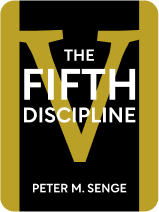

This article is an excerpt from the Shortform book guide to "The Fifth Discipline" by Peter M. Senge. Shortform has the world's best summaries and analyses of books you should be reading.
Like this article? Sign up for a free trial here.
What does Peter Senge mean by a “learning organization”? How does a learning organization compare to a more traditional organization?
According to Peter Senge, a learning organization is flexible. Compared to a traditional organization with a rigid, top-down power structure and strict rules, learning organizations are able to change and evolve with the times as their members do.
Here’s why a learning organization is better for everyone, and how you can create such an organization within your business.
What Is a “Learning Organization“?
According to Peter Senge, a learning organization is an organization that encourages its members to constantly learn and develop their skills, and in turn to use those skills to improve the organization. He argues that a learning organization is better for everyone: It’s both more successful and more fulfilling than a traditional organization.
To create such a learning organization, or convert an existing organization into one, Senge provides five key practices (what he calls disciplines) to start working into your daily life and company culture.
Discipline 1: Constant Personal Growth
To create an evolving organization, the people within that organization must be willing to learn. Senge says that you should see your life as a never-ending learning process and make a commitment to constant growth and self-improvement.
Senge says that personal growth requires two things: clear goals to strive toward, and a creative mindset so you can find ways to reach those goals.
Dedication to constant improvement makes people feel more committed, happier, and more fulfilled in their work—remember, people are naturally driven to learn. However, many companies don’t encourage personal growth because they can’t easily measure its effectiveness. Instead, those companies expect employees to focus on their day-to-day tasks and to do them “by the book,” with no room for personal growth or new discoveries. In doing so, they stifle people’s potential and enthusiasm.
Discipline 2: Constant Worldview Improvement
The second of Senge’s disciplines is to improve your ability to see the big picture by constantly assessing and updating what you think you know.
What Senge calls mental models are the closely-held beliefs and assumptions that make up your worldview. Your worldview affects how you interpret your experiences, and it therefore constantly influences your thoughts and behavior.
Senge adds that it’s impossible to have a completely correct worldview—all worldviews are subjective and simplified versions of the truth. That’s why he calls on us to constantly examine and improve our worldviews: to make them more correct, even though they’ll never be 100% correct.
Senge adds that people often have great ideas about how to improve themselves or their organizations but fail to implement those ideas because they contradict their secretly held beliefs. For example, a store manager might have an idea for a fun event to boost employee morale and customer engagement yet never bring it up because he or she assumes that executives will reject the idea. The manager could challenge this worldview by pitching the idea anyway and seeing if his or her beliefs hold true.
Discipline 3: A Common Mission
A common mission—what Senge calls a shared vision—forms when people orient their personal objectives toward an overarching goal. In other words, an organization comes together and says, “This is the future we want,” and then each member of that organization does his or her best to realize that vision.
Having a common mission gives the organization the energy and perseverance to work toward its long-term goals. Organizations that don’t have a common mission, on the other hand, won’t work as hard because the employees don’t have that motivation.
That doesn’t mean everyone has exactly the same vision, or that they sacrifice their personal aspirations for the common mission. Rather, everyone’s personal motivations influence how they view the common mission: Each person will approach the common mission in a slightly different way based on their own experiences, duties, and worldview. In fact, when coming up with a common mission, Senge advises you to find out what’s most important to each of your employees and to try to work those goals into it.
For example, say a sneaker manufacturer creates a common mission that everybody in the country will have at least one good, solid pair of sneakers. A company survey then reveals that many employees have personal goals of caring for their families and improving the local community. The company might weave those missions together by offering employee discounts (helping them care for their families by giving them shoes) and organizing charity drives to give shoes to impoverished and homeless people (helping employees create positive changes in the community). In this way, a common mission bolsters the company as a whole and the employees as individuals.
Discipline 4: Group Evolution
Group evolution—what Senge calls team learning—is the process by which a group of people learns how to work together effectively and help each other reach their shared goals. Senge says that group evolution has three key aspects:
1) Group-based worldview improvement. As we discussed previously, team members should work together to identify each other’s faulty assumptions and improve each others’ worldviews.
2) Spontaneous teamwork. A team that has learned to work together and evolve together will sometimes take actions that are unplanned, yet perfectly coordinated. Much like a trained and practiced troupe of improvisational actors, the team members understand and trust each other to the point that their teamwork becomes instinctual.
3) Connections with other teams. Remember that your team is just one part of a larger system, and whatever decisions you make will likely need other teams from other parts of the organization to put them into practice. Therefore, it will benefit your team (and the organization as a whole) to promote group evolution practices among those other teams as well.
Discipline 5: Big-Picture Thinking
Most people are taught to break problems apart when trying to solve them. This is because supposedly, it’s easier to learn about one thing at a time and then put the pieces together to see how the whole system works. However, Senge argues that life isn’t made of separate elements; rather, the world is made of countless different elements that come together to form systems. By trying to separate those elements from each other, you misrepresent how the world works and thus make it impossible to really understand what you’re observing.
This is one of Senge’s rules of big-picture thinking: Breaking up a system does not produce smaller versions of that system. For example, imagine trying to learn about cars by studying an engine—you might learn more about that one piece of the system, but you can’t extrapolate the rest of the car from it.
Senge says that businesses often suffer from a lack of big-picture thinking. Instead of operating as one big system—understanding that every part of the business will influence every other part—many companies try to operate as many individual units, with each person or group only paying attention to their own tasks. As a result, the different parts of the organization may interfere with each other without realizing it.
For example, an innovation allowing the company to ship more goods to a warehouse might seem beneficial, but it will put added strain on the warehouse employees and might lead to them quitting. Unless the company also ensures that the warehouse is prepared for the added workload, this apparently profitable innovation will hurt the company in the long run.

———End of Preview———
Like what you just read? Read the rest of the world's best book summary and analysis of Peter M. Senge's "The Fifth Discipline" at Shortform.
Here's what you'll find in our full The Fifth Discipline summary:
- Why an organization should encourage its members to constantly learn and develop their skills
- The five disciplines for creating an evolving organization
- Why you should constantly assess and update what you think you know






